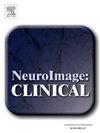Electric field variations across DLPFC targeting methods in TMS therapy for Alzheimer’s disease
IF 3.6
2区 医学
Q2 NEUROIMAGING
引用次数: 0
Abstract
Background
The dorsolateral prefrontal cortex (DLPFC) is crucial for cognitive control and a primary target for transcranial magnetic stimulation (TMS) in Alzheimer’s disease (AD). However, understanding the distribution of TMS-induced electric field (E-field) across different targeting methods remains limited, as does its relationship to therapeutic outcomes.
Objective
This study assesses differences in TMS-induced E-field using functional versus anatomical targeting methods for DLPFC stimulation.
Methods
Functional and anatomical targets were identified in 30 (11 M/19F) AD patients and 30 (13 M/17F) age-matched healthy controls (HCs) using T1 and fMRI data. E-field characteristics, including magnitude (EROI) and normal component (E⊥), were calculated via SimNIBS software for comparisons across stimulation targets.
Results
Functional targeting showed greater spatial dispersion compared to anatomical targeting in both groups. Significant E-field differences were observed between the functional target and adjacent anatomical regions when the coil was positioned over the functional target in both groups. Optimal coil orientation exhibited directional specificity: parallel alignment with the LOI E-field produced higher field intensity in the functional target compared to the anatomical target (AD patients: P < 0.001; HCs: P = 0.052), while perpendicular orientation maintained functional stability with reduced anatomical interference (both groups: P < 0.001). And significant variations in E-field ratios were observed across coil orientations.
Conclusion
This study reveals key E-field disparities across DLPFC targeting approaches and establishes coil orientation optimization as a critical strategy to improve TMS precision, offering actionable insights for developing personalized protocols in AD therapy that may enhance treatment efficacy while minimizing adverse effects.
经颅磁刺激治疗阿尔茨海默病DLPFC靶向方法的电场变化
背外侧前额叶皮层(DLPFC)对认知控制至关重要,也是经颅磁刺激(TMS)治疗阿尔茨海默病(AD)的主要靶点。然而,对tms诱导电场(E-field)在不同靶向方法中的分布及其与治疗结果的关系的了解仍然有限。目的利用功能性和解剖性靶向方法,评估经颅磁刺激诱发的脑电场的差异。方法利用T1和fMRI数据对30例(11 M/19F) AD患者和30例(13 M/17F)年龄匹配的健康对照(hc)进行功能和解剖靶点鉴定。电磁场特征,包括震级(EROI)和法向分量(E⊥),是通过SimNIBS软件计算的,以便在刺激目标之间进行比较。结果两组的功能性靶向均表现出更大的空间离散性。在两组中,当线圈放置在功能靶上时,在功能靶和邻近解剖区域之间观察到显著的电场差异。最佳线圈定向表现出方向特异性:与LOI电场平行对准在功能靶点产生比解剖靶点更高的场强度(AD患者:P <;0.001;HCs: P = 0.052),而垂直取向保持功能稳定,解剖干扰减少(两组:P <;0.001)。在不同的线圈方向上观察到显著的电场比变化。结论本研究揭示了不同DLPFC靶向方法的关键电场差异,并确定了线圈定向优化是提高TMS精度的关键策略,为开发个性化的AD治疗方案提供了可行的见解,这些方案可能会提高治疗效果,同时最大限度地减少不良反应。
本文章由计算机程序翻译,如有差异,请以英文原文为准。
求助全文
约1分钟内获得全文
求助全文
来源期刊

Neuroimage-Clinical
NEUROIMAGING-
CiteScore
7.50
自引率
4.80%
发文量
368
审稿时长
52 days
期刊介绍:
NeuroImage: Clinical, a journal of diseases, disorders and syndromes involving the Nervous System, provides a vehicle for communicating important advances in the study of abnormal structure-function relationships of the human nervous system based on imaging.
The focus of NeuroImage: Clinical is on defining changes to the brain associated with primary neurologic and psychiatric diseases and disorders of the nervous system as well as behavioral syndromes and developmental conditions. The main criterion for judging papers is the extent of scientific advancement in the understanding of the pathophysiologic mechanisms of diseases and disorders, in identification of functional models that link clinical signs and symptoms with brain function and in the creation of image based tools applicable to a broad range of clinical needs including diagnosis, monitoring and tracking of illness, predicting therapeutic response and development of new treatments. Papers dealing with structure and function in animal models will also be considered if they reveal mechanisms that can be readily translated to human conditions.
 求助内容:
求助内容: 应助结果提醒方式:
应助结果提醒方式:


